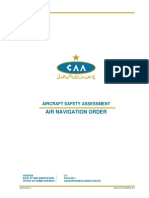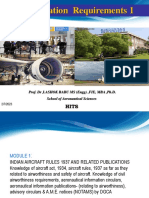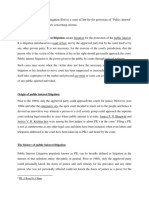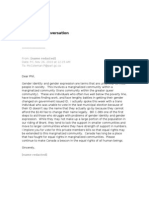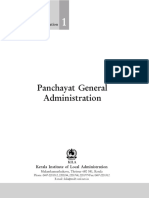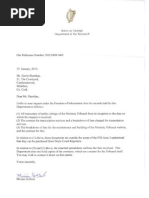TRA UAV-UIN Guideline Comments
TRA UAV-UIN Guideline Comments
Uploaded by
Rishabh SinhaCopyright:
Available Formats
TRA UAV-UIN Guideline Comments
TRA UAV-UIN Guideline Comments
Uploaded by
Rishabh SinhaCopyright
Available Formats
Share this document
Did you find this document useful?
Is this content inappropriate?
Copyright:
Available Formats
TRA UAV-UIN Guideline Comments
TRA UAV-UIN Guideline Comments
Uploaded by
Rishabh SinhaCopyright:
Available Formats
COMMENTS TO THE GUIDELINES FOR OBTAINING UNIQUE IDENTIFICATION NUMBER
(UIN) AND OPERATION OF CIVIL UNMANNED AIRCRAFT SYSTEMS (UAS) ISSUED BY
THE OFFICE OF THE DIRECTOR GENERAL OF CIVIL AVIATION
About the Commentator:
TRA is a law firm specialising in representing new-technology companies in the aerospace and
aviation sectors and represents a significant number of UAS design, manufacturing and operations
companies.
Anirudh Rastogi, Advocate
BA.LL.B. (Hons), LLM (Harvard)
Managing Partner
Rishabh Sinha, Advocate
BA.LL.B. (Hons)
Counsel
Gaurang Singh, Advocate
BA.LL.B. (Hons)
Associate
Contact Information:
TRA
C-6, Gulmohar Park, New Delhi 110 049
Ph: 011-4160 4733, 98991 44333
Email: anirudh@tralaw.in
EXECUTIVE SUMMARY
The draft guidelines dated 22nd April, 2014 provide for the terms and conditions for the ownership and operation of UAs. A summary of our
major comments is provided below:
1. Creation of additional weight category, nano for UAs weighing less than 250 gms, which should be exempt from registration.
2. Web-based system for registering all UAs up to 20kg in weight.
3. Registration for UAs under 5kg should be automatic upon verification of documents and not discretionary.
4. Appointment of an organisation to conduct and facilitate preliminary grant of UIN and UAOP for final confirmation by DGCA.
5. Designate test sites for test flights to facilitate R&D. Test flights conducted from designated sites should not require insurance and
should be granted approvals on a fast-track.
6. The UAOP awarded to a pilot should be linked to a UA type and not to a specific UA.
7. The DGCA should permit fast-tracking of UAOP applications upon payment of significantly higher fees. For UAs weighing less than 20kg,
the suggested (regular-track) timeline should be 15 to 30 days.
8. Limited revival of the now deleted CAR Section 2, Series F, Part XVIII, Issue I dated 23rd October 1992 relating to Construction,
Certification and Operation of Experimental and Amateur Build Aircraft.
ii
9. DGCA should give a blanket permission for import of certain standard components of UAS and popular and reliable models of UAs.
10. Age limit for recreational flying may be relaxed to 13 years.
11. Any kind of photography or videography using UAs including but not limited to surveillance activities should be subject to express
permission of the DGCA and that of the local administration.
12. Any UA operations involving operation of UAs as a fleet whether for a single task or a series of tasks and whether operated by a single
entity or multiple entities acting in concert may only be undertaken with the express permission of the DGCA.
iii
Public Comment TRA/04/2016
DETAILED COMMENTS
S.NO.
ISSUE
RELEVANT PROVISION
TRA RECOMMENDATION
INTERNATIONAL
PRACTICE
REGARDING WEIGHT BASED CATEGORISATION AND REGISTRATION OF UAS
1.
2.
Weight-based
categorisation
of UAs
Registration
Requirement
Clause 3
The draft guidelines classify
civil UAs in accordance with
weight as indicated below:
i) Micro: Less than 2 kg.
ii) Mini: Greater than 2 kg
and less than 20 kg.
iii) Small: Greater than 20
kg and less than 150 kg.
iv) Large: Greater than 150
kg.
We suggest the creation of an additional category,
Nano for UAs weighing less than 250 gm which
should be exempt from registration. Accordingly,
Micro UAs will be revised to mean UAs between
250 gm and 2 kg.
This provision should also be amended to clarify
that the weight of the payload and mandatory fire
proof plate shall be included into the weight of the
UA for the purpose of determining the weight
category
Clause 4
Nano UAs should be exempt from registration.
The draft guidelines provide
for the same registration
process for all UAs
A web-based system should be provided for
registering all UAs up to 20kg in weight.
The FAA, USA
recognises UAs
weighing less than 250
grams (0.55 pounds)
as a separate category
and exempts them
from registration.
The FAA, USA
exempts UAs weighing
less than 250 grams
(0.55 pounds) from
registration. Singapore
has a blanket
S.NO.
3.
ISSUE
Single Window
Registration
RELEVANT PROVISION
irrespective of weightcategory.
Registration for UAs under 5kg should be
automatic upon verification of documents and not
discretionary.
Clause 4.2
The Registration process should be a single
window clearance from the WPC and local police.
The DGCA may reconsider the need for a character
verification.
As per the draft guidelines,
prior to applying for
registration, the registrant is
required to obtain a character
certificate from local police
and permission for use of
frequencies from the WPC,
DoT.
4.
Eligibility for
Registration
TRA RECOMMENDATION
Clause 4.1
The draft guidelines only
provide for grant of UIN to an
Indian citizen.
INTERNATIONAL
PRACTICE
exemption for UAs
weighing below 7 kg
used for noncommercial purposes
from registration.
We recommend that a temporary UIN may be
granted to aliens for R&D purposes, pilot training
and recreational purposes. This will enable the
Indian UAS industry to benefit from expertise
available outside India.
Recreational use should not be restricted in any
way.
The guidelines should also permit residents living in
India for a reasonable period of time (say, 2 years)
to obtain a UIN.
S.NO.
5.
ISSUE
Outsourcing
Preliminary
Processes for
Registration
RELEVANT PROVISION
TRA RECOMMENDATION
The DGCA may appoint an organisation with
individuals having appropriate credentials and
experience in design, manufacture, operations and
testing of UAs to conduct time-bound preliminary
grant of UIN and UAOP, and to co-ordinate with
various government agencies for the same. The
organisation shall also be qualified and permitted
to counsel the applicant for a fee on completing the
application and meeting the standards prescribed
or expected by the DGCA for final approvals.
Such a two-tier process will be beneficial for both
the regulator and the industry. The DGCA will
benefit from lower workload since the preliminary
evaluation will be done by an external agency and
the applications forwarded to the DGCA will be in
line with the expectations of the DGCA. The
industry will benefit from faster turn-around and
handholding which otherwise the regulator will
neither be able to nor permitted to offer.
INTERNATIONAL
PRACTICE
Worldwide, aviation
regulators are being
subjected to an
increased workload
and resource crunch
because of the
number of industry
applications for
approvals.
The CAA, UK, has
appointed an external
agency (EuroUSC) to
evaluate and
recommend
organisations to the
CAA, UK for grant of
exemption for certain
operation approvals.
EuroUSC is permitted
to counsel such
organisations for a fee
and help them meet
design standards that
may be acceptable to
the CAA, UK.
REGARDING TEST FLIGHTS AND R&D
S.NO.
6.
ISSUE
Temporary UIN
for Test Flights
RELEVANT PROVISION
Clause 4
The draft guidelines require
every UA to carry a UIN.
7.
Test Sites/ Free
Fly Zones
8.
Manufacturing
standards
It is unclear what standards
manufacturers must follow
while developing UAVs. By
necessary implication,
CAR21 applies, the
standards of which
TRA RECOMMENDATION
INTERNATIONAL
PRACTICE
There should be a provision for grant of temporary
UIN for test flights for manufacturing/R&D. If India
has to maintain a lead in the UAS industry, an
enabling regulatory framework for R&D, and in
particular for test flights is essential. A provision for
temporary UINs that can be awarded quickly for
evolving prototypes will facilitate R&D.
The FAA, USA and
CAA, UK currently
provide a special
certificate in the
experimental category
/ permit to fly to
enable operations at a
constrained level.
These certificates are
provided on a case to
case basis. The FAA,
USA has already
issued hundreds of
airworthiness
certificates.
The DGCA in consultation with concerned agencies
should designate test sites in various parts of the
country where approved UAOP holders may test
prototypes of all weight-categories pursuant to a
fast-track approval and without other requirements
such as insurance.
The FAA, USA has
designated six test
sites in the US. Some
sites have been
opened in affiliation
with leading
universities.
In the absence of any guidelines for the same,
Indian entrepreneurs will concede an unfair
advantage to foreign manufacturers operating in
jurisdictions with enabling regulations for design
and manufacturing.
S.NO.
ISSUE
RELEVANT PROVISION
TRA RECOMMENDATION
practically cannot be applied
for development of UAs, in
particular for prototypes and
new concepts.
This will be a good opportunity to make a limited
revival of the now deleted CAR Section 2, Series F,
Part XVIII, Issue I dated 23rd October 1992 relating
to Construction, Certification and Operation of
Experimental and Amateur- Build Aircraft. This part
of CAR provided guidance on the building and
certification of amateur built aircraft and laid down
eligibility criteria for amateur-built certification in
the Experimental Category. Many new ideas and
concepts originate with small aircraft built by the
non- professional designer. This activity will be
destroyed by excess regulation. Appropriate
amendments to include UAs, will provide a much
needed impetus to R&D in aviation in India.
INTERNATIONAL
PRACTICE
REGARDING OPERATORS AND UA OPERATOR PERMITS (UAOPS)
9.
Definition of
Operator
Clause 2
The draft guidelines do not
define the term Operator.
The term Operator may be defined to mean: A
person, organisation or enterprise engaged in or
offering to engage in an aircraft operation. This
definition clarifies that organisations can also be
deemed to be operators, and accordingly, both the
individual operating the UA as well as the
organisation employing such individual will be
responsible for the operation of the UA.
The suggestion
definition has been
borrowed from the
ICAO Circular No. 328AN/190
S.NO.
10.
11.
12.
13.
ISSUE
RELEVANT PROVISION
Linkage
between UAOP
and UIN
Clause 6.4(f)
Timeline for
grant of UAOP
Clause 6.2.
Renewal of
UAOP
Security
Clearance from
BCAS
The draft guidelines suggest
that each UAOP shall be
linked to a UA/UIN.
The draft guidelines require
the submission of UAOP
application at least 90 days
prior to actual conduct of UA
operations.
Clause 6.5.
The draft guidelines prescribe
that there should be renewal
of NOC which would require
security clearance from
Ministry of Home Affairs
(MHA) and Bureau of Civil
Aviation security (BCAS).
Clause 6.1.(e)
TRA RECOMMENDATION
INTERNATIONAL
PRACTICE
The UAOP awarded to a pilot should be linked to a
UA type and not to a specific UA. The pilot should
be able to use her UAOP with any UA of the same
type, especially in case of Nano, Micro and Mini
categories.
The 90 day timeline should be a retained as a
suggestion for the applicants and not be
prescribed as mandatory.
The DGCA should also permit fast-tracking of
UAOP applications upon payment of significantly
higher fees.
For UAs weighing less than 20kg, the suggested
timeline should not be more than 15 days.
The draft guidelines do not require prior permission
or NOC from the MHA for first-time registration.
Accordingly, no such NOC should be required for
renewal. Like in first time registration, a copy of the
renewal may be forwarded to the MHA.
However, if the NOC requirement is not dispensed
with then it is suggested that all such approvals are
obtained by the DGCA as part of a single window
system of clearances.
UAs weighing less than 7kg (or at least 2kg) should
be exempt from obtaining BCAS approval.
S.NO.
14.
ISSUE
Information of
Commencement
of Operations
RELEVANT PROVISION
TRA RECOMMENDATION
The draft guidelines mandate
that firms and operators need
to take security clearance
from BCAS before they start
their civil operations.
In furtherance of establishing a Single Window
System for clearances, DGCA should get this
clearance for the firm/ operator on the basis of the
documents that are submitted to DGCA by the
firm/ operator.
Clause 10.1. / 10.10
We suggest that information to Local
Administration should be exempt for recreational
flying of Micro UAs below 200ft.
Further, a web-based system may be developed
for operators to share flight information with
concerned authorities.
The draft guidelines provide
that irrespective of weight
category, the UAS operator
shall intimate Local
Administration, ATS unit (for
operations at or above 200ft
AGL in uncontrolled
airspace), BCAS, Aerodrome
operator ( if applicable)
before commencement and
after termination of operation.
In event of cancellation of
operations, the operator shall
notify the same to all
appropriate authorities as
soon as possible.
INTERNATIONAL
PRACTICE
S.NO.
15.
ISSUE
Applicability of
Rules of Air to
UAs
RELEVANT PROVISION
Clause 10.5.
The draft guidelines prescribe
UA shall be operated in
accordance with the rules
governing the flights of
manned aircraft as specified
in the CAR Section 9, Series
C, Part I (Rules of Air)
TRA RECOMMENDATION
Rules of Air as they stand currently need to be
adapted for use with UAs as many of its provisions
will either be irrelevant, onerous or incompatible
with some categories of UAs, especially, Micro and
Small UAs.
INTERNATIONAL
PRACTICE
Internationally,
regulators are also
developing Air Traffic
Rules and Rules of Air
which are suited for
civilian UAs as the
Rules of Air for
manned aircrafts are
designed to address a
different threshold of
risk.
REGARDING RESTRICTIONS FOR PILOTS
16.
Age Restriction
on Remote Pilot
Clause 8.1.
Training Requirements for
Remote Pilots:
The draft guidelines provide
that the prescribed training
requirements are not
applicable to micro UAs and
recreational flying, however it
is unclear whether the age
limit of 18 years for remote
pilots applies to micro UAs
and recreational flying.
The guidelines should be amended to clarify that
age limit of 18 years shall not apply to Nano UAs
and for Micro UAs flown for recreational purposes
below 200ft AGL. The limit may be relaxed to 13
years.
The FAA, USA
prescribes a 13 year
age limit for both
registration and flying.
S.NO.
17.
ISSUE
Ground Training
requirement for
Remote Pilots
RELEVANT PROVISION
Clause 8.1.
The draft mandates a remote
pilot to have taken training
equivalent to that undertaken
by aircrew of manned aircraft
or a PPL holder
(aeroplane/helicopter) with
FRTOL.
TRA RECOMMENDATION
INTERNATIONAL
PRACTICE
The training requirements for UAs weighing less
than 20kg will need to be adapted to make them
relevant to such remote pilots to include modules
relating specifically remote piloting and a
concomitant reduction of parts relevant to manned
aircrafts.
REGARDING AEROMODELLING AND MODEL AIRCRAFTS
18.
Aero modelling
Clause 5.3(b)
Aero modelling activities
carried out within premises of
educational institutions alone
are considered recreational.
19.
Payload for
Model Aircraft
Clause 2
Model Aircrafts are defined to
mean UAs without payload
used for recreational
purposes only.
The DGCA may register aero modelling clubs
based on certain eligibility criteria. Flights by
members within the premises of such clubs may be
considered as recreational and may further be
exempt from the altitude limitation (200 ft AGL)
applicable to recreational flights. Provided that
such flights shall be subject to community based
set of safety guidelines adopted by such clubs.
There should not be an omnibus restriction on
payloads for recreational flights. The DGCA may
issue a general list of approved payloads such as
light cameras. A model aircraft fitted with a camera
for personal photography should be classified as
recreational.
Section 336 of the
United States
Modernization and
Reform Act, 2012 does
not exclude payload
from model aircrafts
S.NO.
ISSUE
RELEVANT PROVISION
TRA RECOMMENDATION
The DGCA may also encourage aero modelling
clubs to adopt community based safety standards
and permit members of such registered aero
modelling clubs on a case to case to attach
payloads to model aircrafts so long as they are in
line with the DGCA approved community based
safety guidelines.
INTERNATIONAL
PRACTICE
and recognises
community based
safety guidelines for
such use.
REGARDING OTHER MISCELLANEOUS ISSUES
20.
Definition of
Civil Operations
There is ambiguity as to the definition of Civil
Operations, especially in light of the previous
DGCA notice restricting UAS operations in Indian
airspace dated 07.10.2014. The guidelines should
clarify if they apply to government operations as
well, especially in case of sue by law enforcement
agencies, PSUs etc.
21.
Fleet
Operations
Where it is intended that a task to be achieved by a
UAS will be completed using a fleet of UAs,
whether towards the achievement of single task or
a series of tasks and whether operated by a single
entity or by multiple entities acting in concert
should be undertaken with the express permission
of the DGCA.
10
S.NO.
ISSUE
22.
Definition of
Unmanned
Aircraft (UA)
Clause 2
Import
Permission from
DGCA
Clause 6.7.
23.
24.
Prohibition on
Sale/Disposal of
UAS without
permission
RELEVANT PROVISION
The draft guidelines define
Unmanned Aircraft as an
aircraft which is intended to
operate with no pilot on
board.
The draft guidelines
necessitate obtaining an
import permission from
DGCA based on which DGFT
shall provide a license for
import of UAS.
Clause 7.1.
The draft guidelines provide
that the UAS shall not be sold
or disposed of in any way to
any person or firm without
permission of DGCA.
TRA RECOMMENDATION
The definition of UA should expressly exclude
traditional balloons, tethered aircrafts, hot air
balloons, unpowered gliders, rockets and other
self-propelled vehicles. The said aircrafts are to be
regulated separately, and such exclusion would
avoid confusion regarding the applicability of these
guidelines.
INTERNATIONAL
PRACTICE
The FAA, USA
specifically excludes
these aircrafts from
the definition of UAs.
We suggest that DGCA should give a blanket
permission for import of certain standard
components of UAS or popular and reliable models
of UAs, so that excessive permissions do not
burden regulators, developers and users of UAs.
For other parts and UAS a timeline of 30 days may
be prescribed for approval from DGCA. A single
window clearance from both DGCA and DGFT may
be considered. The Indian UAS industry will benefit
from such access to foreign technology.
A part of the process of transfer of UAS, like in
case of automobiles, will require transfer of UIN
associated with such UAS. The guidelines should
lay down the procedure for such transfer. Ideally,
the process for transfer for Nano and Micro UAs
should be intimation based.
11
S.NO.
ISSUE
RELEVANT PROVISION
TRA RECOMMENDATION
INTERNATIONAL
PRACTICE
A timeline of 30 days may be prescribed for grant
of permission by DGCA for sale of any UAs
weighing more than 2kg but less than 20kg.
The guidelines should clarify that nothing in this
clause will restrict lease / rental of a UA to a valid
UAOP holder concerning the same UA type. This
will reducing the capex associated with the
purchase of a UA and will facilitate low-cost UA
applications/operations.
25.
26.
Flying over the
territory of Delhi
Clause 10.13.
Privacy
Clause 10.4
The draft guidelines prohibit
the UA to be flown over the
entire air space over the
territory of Delhi (30 km
radius from Rashtrapati
Bhavan)
The draft guidelines provide
that privacy and protection of
personnel/property/data shall
be given due importance
A blanket restriction over Delhi will be unnecessary.
The restriction may be relaxed as follows:
1. Nano UAs: May be operated outside a
radius of 3 km from Rashtrapati Bhawan;
2. Micro and Mini UAs: May be operated
outside a radius of 15km from Rashtrapati
Bhawan.
The draft guidelines do not provide a detailed
framework for privacy and protection of data. Any
photography or videography activities especially
activities like surveillance in residential areas
should be with express permission from the DGCA
and the local administration. Policies relating to
retention of data from any photography or
videography activities should be mandated.
12
S.NO.
27.
28.
29.
ISSUE
RELEVANT PROVISION
Rain/
Thunderstorm
Warning
Clause 10.16.
Detect and
Avoid / Return
Home Capability
Clause 10.23
Maintenance of
Records
Clause 9.4.
The draft guidelines lay down
that the UAS operator shall
not launch the UA when rain/
thunderstorm warning is in
force
The draft guidelines require
all UAs to have detect and
avoid and home return
capability.
The draft guidelines require
that the UAOP holder shall
maintain records of each UA
flight and makes such
records available to the
DGCA on demand.
30.
Insurance
Clause 12.
The draft guidelines mandate
all UAOP holders to have
insurance with the liability
that they might incur for any
TRA RECOMMENDATION
INTERNATIONAL
PRACTICE
The guidelines should direct operators to an
authoritative source for checking the weather
online. This source shall be relied upon by the
DGCA as well as operators to avoid any confusion.
Current technology and associated costs may not
allow for (or may render unviable) building such
features in to Nano and Micro category UAs. Since,
such UAs are largely flown within VLOS, have
limited range and impose limited risk, such a
requirement may be dispensed with.
We suggest that such records should be
maintained only for a maximum period of 1 year for
all UAs except Large UAs for which the records
should be maintained for 7 years.
We also suggest that it should not be mandatory to
maintain such records for UAs flown for
recreational purposes.
We suggest that this provision should not apply to
i) UAs weighing less than 2kg flown for recreational
purposes, and ii) prototypes flown in designated
test sites.
13
S.NO.
ISSUE
RELEVANT PROVISION
TRA RECOMMENDATION
INTERNATIONAL
PRACTICE
damage to third parties
resulting from the accident/
incident.
31.
Penalty
Clause 13
In the event of any noncompliance, the draft
guidelines only provide for
cancellation or suspension of
the UAOP.
Bearing in mind the dangers of non-compliant use
of UAs, this penalty may be insufficient. It may be
mentioned that aside from action that may be
taken under the Aircraft Act, 1934 and Aircraft
Rules, 1937 (e.g. for dangerous flying, carriage of
arms, operations without permit etc.), action may
also be preferred against defaulters under the
applicable provisions of The Suppression of
Unlawful Acts against Safety of Civil Aviation Act,
1982, Anti-Hijacking Act, 1982 etc.
END
14
TRA
C6, Gulmohar Park, New Delhi
Ph: 011-4160-4733; +91 9899144333
www.tralaw.in
15
You might also like
- Drone Pilots-Instructor Notes (Study Guides) IndiaDocument253 pagesDrone Pilots-Instructor Notes (Study Guides) IndiaSS100% (4)
- 01-CPD-8, Civil Aviation Procedure Document On Airworthiness-MinDocument884 pages01-CPD-8, Civil Aviation Procedure Document On Airworthiness-Minnishat529100% (1)
- KP 237 Tahun 2018 Staff Instruction 67-01Document57 pagesKP 237 Tahun 2018 Staff Instruction 67-01Alexander RezaNo ratings yet
- Air Navigation Order: Aircraft Safety AssessmentDocument10 pagesAir Navigation Order: Aircraft Safety AssessmentMuneeb AlamNo ratings yet
- Airport RegulationsDocument265 pagesAirport RegulationsPratik JhaNo ratings yet
- AOI 13 Airside Driving Training and Regulations of Airside Safety PDFDocument23 pagesAOI 13 Airside Driving Training and Regulations of Airside Safety PDFSatyendra Pandey100% (1)
- Starting A CasDocument81 pagesStarting A CasTc AdfoNo ratings yet
- Foreign Licence Validation Certificates Under Part VII of The Canadian Aviation RegulationsDocument25 pagesForeign Licence Validation Certificates Under Part VII of The Canadian Aviation Regulationsghudic5743No ratings yet
- FAR-AMT 2021: Federal Aviation Regulations for Aviation Maintenance TechniciansFrom EverandFAR-AMT 2021: Federal Aviation Regulations for Aviation Maintenance TechniciansRating: 5 out of 5 stars5/5 (2)
- Civil Aviation Act 2006Document6 pagesCivil Aviation Act 2006Iludiran KolaNo ratings yet
- Name:Ifra Shahid Reg.: 70081269 Program: BSAM Course: Corporate Aviation Instructor: Sir Naeem Mobashar Semester:6ADocument3 pagesName:Ifra Shahid Reg.: 70081269 Program: BSAM Course: Corporate Aviation Instructor: Sir Naeem Mobashar Semester:6AAli HasanNo ratings yet
- Icao Bcar AerodromesDocument24 pagesIcao Bcar AerodromesIgnacio TabuadaNo ratings yet
- Day 2 Workshop 6 National Regulations Karen Tarr - Canadian Unmanned Aircraft Systems RegulationsDocument10 pagesDay 2 Workshop 6 National Regulations Karen Tarr - Canadian Unmanned Aircraft Systems RegulationsPedro Tati BarrosNo ratings yet
- About DDPMASDocument4 pagesAbout DDPMASMD Hussain100% (1)
- Civil Aviation SectorDocument80 pagesCivil Aviation SectoritssosimpleNo ratings yet
- Critical Review of Global Regulations For Certification and Operation of AirshipsDocument9 pagesCritical Review of Global Regulations For Certification and Operation of AirshipsvivekNo ratings yet
- Guinn Partners BVLOS EbookDocument30 pagesGuinn Partners BVLOS Ebookmartin13131313No ratings yet
- Research Paper: Nalsar University of Law, HyderabadDocument16 pagesResearch Paper: Nalsar University of Law, HyderabadMayank LabhNo ratings yet
- Certification Scheme For Remotely Piloted Aircraft Systems (RPAS)Document8 pagesCertification Scheme For Remotely Piloted Aircraft Systems (RPAS)Surya Teja SarmaNo ratings yet
- Summarization On ICAO Annex 1Document4 pagesSummarization On ICAO Annex 1Shazlan SnickersNo ratings yet
- Assembly - 37Th Session: Working PaperDocument4 pagesAssembly - 37Th Session: Working Paperkrk.10002039No ratings yet
- COP - Safety Standards For Class IV VesselsDocument94 pagesCOP - Safety Standards For Class IV VesselsFerfer BarbarNo ratings yet
- RGS WG4-WP17 - UAE Offshore Aerodromes Regulatory Framework - ICAODocument170 pagesRGS WG4-WP17 - UAE Offshore Aerodromes Regulatory Framework - ICAOCJ SamNo ratings yet
- A Critical Review of Global Regulations For Certification and Operation of AirshipsDocument9 pagesA Critical Review of Global Regulations For Certification and Operation of Airshipsgustavojorge12No ratings yet
- Drone Regulation of India and Comparison With Other Countries Drone LawsDocument6 pagesDrone Regulation of India and Comparison With Other Countries Drone LawsRachitha S SomashekarNo ratings yet
- Legal Requirements For The Manufacturing of Drones in IndiaDocument6 pagesLegal Requirements For The Manufacturing of Drones in IndiaSubrata MukherjeeNo ratings yet
- AC_120-95ADocument12 pagesAC_120-95AEdison David Samaniego PánchezNo ratings yet
- Faa Mosaic 2023-14425Document318 pagesFaa Mosaic 2023-14425rpanagNo ratings yet
- CG5049 - Drone Law CanadaDocument4 pagesCG5049 - Drone Law CanadaBogdan DragomirNo ratings yet
- Certification Standards For Civil UavsDocument15 pagesCertification Standards For Civil UavsMartin EliasNo ratings yet
- Licensing Applications Guidance General 2014Document13 pagesLicensing Applications Guidance General 2014twat neckNo ratings yet
- 1 Regulation of Drones 13Document12 pages1 Regulation of Drones 13Raisa ColeNo ratings yet
- Civil Air RegulationsDocument99 pagesCivil Air Regulations4tj4p9xzf8No ratings yet
- Ano-006-Aweg-4.0 - Aircraft Design Certification RequirementsDocument19 pagesAno-006-Aweg-4.0 - Aircraft Design Certification Requirementsafa.maintNo ratings yet
- MP Avt 273 08Document16 pagesMP Avt 273 08daniel.dupreNo ratings yet
- Amateur-Built Arc Final Report 2006Document15 pagesAmateur-Built Arc Final Report 2006endalkachew gudetaNo ratings yet
- ULDR Workshop PresentationDocument67 pagesULDR Workshop Presentationvakarpov100% (1)
- Aircraft Inspections: Richard D. Mileham Airworthiness Safety Program Manager Great Lakes RegionDocument83 pagesAircraft Inspections: Richard D. Mileham Airworthiness Safety Program Manager Great Lakes RegionRani Triani0% (1)
- Airport Operations and Federal Aviation Regulation Part 139-CertificationDocument46 pagesAirport Operations and Federal Aviation Regulation Part 139-CertificationmarwanassiNo ratings yet
- Wa0003.Document22 pagesWa0003.enishetty amarNo ratings yet
- CAP 658 Model Aircraft: A Guide To Safe Flying: Safety Regulation GroupDocument54 pagesCAP 658 Model Aircraft: A Guide To Safe Flying: Safety Regulation GroupGSAT200No ratings yet
- CAA AC AWS005 Mandatory Continuing Airworthiness InformationDocument5 pagesCAA AC AWS005 Mandatory Continuing Airworthiness InformationgeoffNo ratings yet
- Government of India Technical Center, Opposite Safdarjung Airport, New DelhiDocument29 pagesGovernment of India Technical Center, Opposite Safdarjung Airport, New DelhiPrabhhakar KushwahaNo ratings yet
- Cap722a UasoscDocument52 pagesCap722a UasoscliboyyxNo ratings yet
- ABS RuleDocument58 pagesABS RuleDrs RathnayakeNo ratings yet
- CertificatesDocument5 pagesCertificatesYasminNo ratings yet
- Ano-006-Awrg-2.0 DT 4TH April 2011 PDFDocument9 pagesAno-006-Awrg-2.0 DT 4TH April 2011 PDFSahil KhanNo ratings yet
- Npa 09-2013 - Caap 71 Helidecks (Off-Shore)Document32 pagesNpa 09-2013 - Caap 71 Helidecks (Off-Shore)Legend AnbuNo ratings yet
- TableDocument27 pagesTableNorozKhanNo ratings yet
- Car 1 PDFDocument74 pagesCar 1 PDFAbin BobanNo ratings yet
- Rief On Testing and Certification Procedures in Military Aviation SectorDocument1 pageRief On Testing and Certification Procedures in Military Aviation SectorkadiravannnNo ratings yet
- Consultation Paper 3.6 The Regulation of Aviation Safety: Executive SummaryDocument8 pagesConsultation Paper 3.6 The Regulation of Aviation Safety: Executive SummaryEdward Handy SatioNo ratings yet
- Section 1 Leaflet 1 (Rev 1)Document9 pagesSection 1 Leaflet 1 (Rev 1)DG TANo ratings yet
- CAR QuestionDocument25 pagesCAR QuestionbirendraNo ratings yet
- Technical Airworthiness Management Manual: Uncontrolled If PrintedDocument8 pagesTechnical Airworthiness Management Manual: Uncontrolled If PrintedDG TANo ratings yet
- 2008 22 01Document11 pages2008 22 01ac_umairNo ratings yet
- Rpas RegulationsDocument57 pagesRpas RegulationsRosaBonillaNo ratings yet
- Kowledge - Requirements 2014Document41 pagesKowledge - Requirements 2014Suzuki AbdullahNo ratings yet
- 2024 – 2025 FAA Drone License Exam Guide: A Simplified Approach to Passing the FAA Part 107 Drone License Exam at a sitting With Test Questions and AnswersFrom Everand2024 – 2025 FAA Drone License Exam Guide: A Simplified Approach to Passing the FAA Part 107 Drone License Exam at a sitting With Test Questions and AnswersNo ratings yet
- 2024-2025 FAA Drone License Exam Guide: A Simplified Approach to Passing the FAA Part 107 Drone License Exam at a sitting With Test Questions and AnswersFrom Everand2024-2025 FAA Drone License Exam Guide: A Simplified Approach to Passing the FAA Part 107 Drone License Exam at a sitting With Test Questions and AnswersNo ratings yet
- Origin of Public Interest Litigation: PilaboonorabaneDocument14 pagesOrigin of Public Interest Litigation: PilaboonorabaneRitikaSahniNo ratings yet
- Paras V ComelecDocument2 pagesParas V ComelecGladys BantilanNo ratings yet
- Phil McColeman Email Exchange On Bill C-389Document4 pagesPhil McColeman Email Exchange On Bill C-389Dump PhilNo ratings yet
- Van and Room Arrangements For Mop DavaoDocument3 pagesVan and Room Arrangements For Mop DavaoLaila FarhatNo ratings yet
- Protective Discrimination Under The Indian ConstitutionDocument3 pagesProtective Discrimination Under The Indian ConstitutionArkaprava Bhowmik100% (2)
- 01 Panchayath General AdministrationDocument232 pages01 Panchayath General AdministrationLLM 2019100% (1)
- Tunjung Dharmalia, DR, MPH: Health SystemDocument29 pagesTunjung Dharmalia, DR, MPH: Health SystemUtari UbNo ratings yet
- Certificate of Recognition - 2nd QuarterDocument3 pagesCertificate of Recognition - 2nd QuarterJessy EbitNo ratings yet
- May 2021 Hyderabad ZoneDocument4 pagesMay 2021 Hyderabad ZoneYakshit JainNo ratings yet
- 3783 9181 1 PB PDFDocument43 pages3783 9181 1 PB PDFKrislynAnnNo ratings yet
- GT VAN HOA ANH PDFDocument89 pagesGT VAN HOA ANH PDFHatha NguyenNo ratings yet
- Roinn An Taoisigh Department of The TaoiseachDocument2 pagesRoinn An Taoisigh Department of The TaoiseachthestorydotieNo ratings yet
- Address For Eid CardsDocument12 pagesAddress For Eid CardsHamad GulNo ratings yet
- Obiasca v. BasalloteDocument9 pagesObiasca v. BasalloteKarla BeeNo ratings yet
- DIGESTDocument2 pagesDIGESTAnonymous 5dZOLd0UkNo ratings yet
- Ong Cha v. RepublicDocument13 pagesOng Cha v. RepublicMiguel FontanillaNo ratings yet
- Finaldraft 2Document14 pagesFinaldraft 2api-247831251No ratings yet
- in This Case, Upon The Execution of The Deed of Donation and The Acceptance of Such Donation inDocument2 pagesin This Case, Upon The Execution of The Deed of Donation and The Acceptance of Such Donation inJepoy FranciscoNo ratings yet
- CIR V SolidbankDocument14 pagesCIR V Solidbankrj_guzmanNo ratings yet
- Pro / Con Debate: BIRT The Permanent Seats On The UN Security Council Be Abolished (Con)Document5 pagesPro / Con Debate: BIRT The Permanent Seats On The UN Security Council Be Abolished (Con)Jason FokNo ratings yet
- (Annex C.) SPADocument2 pages(Annex C.) SPAJoy QuerubinNo ratings yet
- Thornton Et Al v. New York Islanders Hockey Club, L.P. - Document No. 14Document3 pagesThornton Et Al v. New York Islanders Hockey Club, L.P. - Document No. 14Justia.comNo ratings yet
- Non Aligned MovementDocument10 pagesNon Aligned MovementNeil PintoNo ratings yet
- The African Charter On Human and Peoples' Rights: A Legal AnalysisDocument25 pagesThe African Charter On Human and Peoples' Rights: A Legal AnalysisAkanksha SinghNo ratings yet
- LINA NEW ResearchDocument43 pagesLINA NEW ResearchLieltNo ratings yet
- Definition of ConstitutionDocument5 pagesDefinition of ConstitutionPablo AvelinoNo ratings yet
- Hannah Serrana vs. SandiganbayanDocument2 pagesHannah Serrana vs. Sandiganbayantimmelicious100% (1)
- Valmonte v. de Villa (Searches and Seizures)Document1 pageValmonte v. de Villa (Searches and Seizures)anna beeNo ratings yet
- Married Daughter Can't Claim Continuous Possession of Her Mothers' Property, It Is Contrary To The Customs, Read HC JudgementDocument20 pagesMarried Daughter Can't Claim Continuous Possession of Her Mothers' Property, It Is Contrary To The Customs, Read HC JudgementLatest Laws TeamNo ratings yet
- Samir GeageaDocument4 pagesSamir GeageailpostinoNo ratings yet



